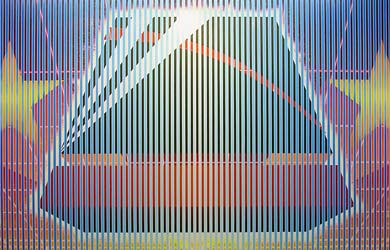
Marc Handelman, Trusted, Independent, Powerful, 2006
Oil on canvas , 108 x 216 inches
Empire of the Eye
February 2- March 3, 2007
Opening Reception: Friday, February 2, 6-8pm
Last year I interviewed painter Marc Handelman for the online startup Fanzine, and as it undoubtedly became the most interesting conversation I had about painting in 2006, I was naturally quite curious when he told me about his upcoming at Sikkema Jenkins. We spoke about a variety of topics, but the most interesting part of the conversation to look at now involves how he saw his work evolving, because of course you can see everything he discusses in his now work, (at least in as much as you can tell from the five jpegs on the gallery website – but what a set of reproductions.) I have quoted an excerpt from the interview below where Handelman speaks about moving away from landscapes and his interest the pathology and desire for power and space.
Screenshot AFC
PADDY JOHNSON: In your last show at Lombard Fried, the work very often depicted landscapes as some sort of barrier to light. There was a sense that growth was happening all around you, and you had no control over its direction or what it did. They are strange, bittersweet fantasies. In your newest body of work, landscape seems to play a far less dominate role. What prompted the change in your paintings?
HANDELMAN: I suppose I thought about the paintings themselves as a kind of barrier or void—an obfuscation to some wholly other event. But for me, the light and the darkness are always the same. They both collapse into the same kind of abyss. But I'm less interested in a relationship to nature than in landscape painting as a framework for pathologies and desires about power and space. So “nature” in my work is always a foil. I think the first time I really started thinking about Luminism was when I painted “Soft Ascent”—that execution viewing window and architectural facade. I had initially painted in a curtain, wanting to eradicate the view altogether. Maybe that kind of speaks to that “barrier to light” that you just mentioned, but then I painted it out with this warm peachy radiant light like a Sanford Gifford painting. There's this feeling in Gifford's work, of everything just vanishing—the mountains, the trees, the distance and even the viewer. And it's such a clean annihilation too, not like [J.M.] Turner or [Frederick] Church's sublime. It's a dissolution that's totally disarming and beautiful and I thought maybe that's the feeling you might have from, say, a lethal injection.
PADDY JOHNSON: You are obviously thinking about painting and the history of painting quite a bit. You mention Luminism, and your work references the Hudson School of Painting, as well as Abstract Expressionism. I would imagine those who deal with landscape and propaganda are of great interest to you. Do the prints of The Steinberg Brothers have any interest to you? Who else are you looking at?
HANDELMAN: I'm only superficially aware of The Steinberg Brothers. Unfortunately, I missed the show at the MOMA too. I'm always thinking about design, but it's a much less focused or researched area for me, which is fine. I sort of approach it more intuitively. In terms of structure, I think there's an interesting relationship between the American Precisionists, and even O'Keeffe's early city-scape paintings and a lot of early 20th century design work—the Bauhaus and, of course, political propaganda. There's this fascination with machines, the geometry of modernity, the monumental and especially light. Paul McCarthy has been really important to me for a while, which says very little actually, as he's so influential. But I'm particularly interested in the relationship between kitsch, monumentality and fascism in his work. I'm also interested in the way McCarthy uses space, its inversions, voids and its disorientating functions. Its kitsch is of such an American flavor too. Kara Walker's work has also been incredibly influential, it's a constant model. I've also been reading and looking at as much Ruscha as possible. He's definitely part of my daily thoughts in the studio. But most recently, I've been thinking about Riley and Op art. Perhaps there's this space in the physiological response to an image that has some pretty disquieting implications and ideas regarding the manipulation of agency and rationality in the viewer.
To read the full interview click here.


Comments on this entry are closed.